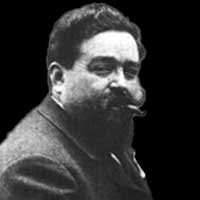Isaac Albeniz - Biography
Isaac Albeniz Biography
Isaac Manuel Francisco Albéniz (May 29, 1860 – May 19, 1909) was a Spanish pianist and composer, best known for his piano works that are based on Spanish folk music.
Born in Camprodon, Catalonia, Albéniz was a child prodigy who first performed at the age of four. At age seven he passed the entrance examination for piano at the Paris Conservatoire, but he was refused admission for his unruly behavior. After going to the Madrid Conservatory, he ran away and became a vagabond, making a living by playing. By age fifteen, he had already given concerts worldwide. After a short stay at the Leipzig conservatory, in 1876 he went to study in Brussels. In 1880, he went to Budapest to study with Franz Liszt, only to find out that Liszt was in Weimar, Germany.
In 1883 he met the teacher and composer Felipe Pedrell (1841–1921), who inspired him to write Spanish music such as the Suite Espańola, Op. 47. The Fifth Movement of that suite, called Asturias (Leyenda) is probably most famous these days in the classical guitar world, even though it was originally composed for piano, and only later transcribed to guitar by Francisco Tárrega.
During the 1890s Albéniz lived in London and Paris and wrote mainly theatrical works. In 1900 started to suffer from kidney disease and returned to the writing of piano music. Between 1905 and 1909 he composed his most famous work, Iberia (1906–1909), a suite of twelve piano 'impressions'.
Albéniz died in 1909 at age 48 in Cambo-les-Bains and is buried in the Cemeteri del Sudoest, Barcelona.
External links
- The Life and Music of Isaac Albéniz (http://www.lib.umd.edu/PAL/YALE/albeniz1.html)
- Albeniz's Scores by SheetMusicArchive (http://www.sheetmusicarchive.net/single_listing.cfm?composer_id=1)
This biography is published under the GNU Licence
